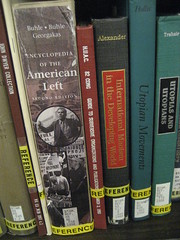Solid research requires the use of all three types of sources:
Primary sources will provide the raw data for your research, but you will also need encyclopedias, dictionaries, subject guides and other reference tools to gather background information and to identify the people, places, dates, organizations, and themes central to your topic. Secondary sources such as books, scholarly journal articles, and newspapers synthesize current research and help put your topic into context. Secondary sources are also important for helping you position your own argument within the scholarly conversation.
Wayne C. Booth, Gregory G. Colomb, and Joseph M. Williams. The Craft of Research, 3rd ed. Chicago: Univ of Chicago Press, 2008.
This book is highly recommended for its clear and reasoned methodology and guidance on developing a tangible research thesis.
Call Number: Bobst Reserves Q180.55.M4 B66 2008; Tamiment Ref Q180.55.M4 B66 2008;
William Cronon. Learning to Do Historical Research: A Primer for Environmental Historians and Others
http://www.williamcronon.net/researching/index.htm .
Although this website was created with environmental historians in mind, it is intended to assist "anyone seeking to learn the craft of doing historical research." The website follows the steps outlined in The Craft of Research.
Thomas Mann. The Oxford Guide to Library Research: How to Find Reliable Information Online and Offline, 3rd ed. New York: Oxford Univ Press, 2005.
Every researcher should consult this excellent volume before embarking on a project. The Guide covers encyclopedias, subject headings and the library catalog, browsing, periodical indexes, keyword searches, citation searches, related record searches, review articles, published bibliographies, hidden resources, and more.
Call Number: Bobst Ref1 Z710 .M23 1998; Tamiment Z710 .M23 1998.
Jenny Presnell. The Information Literate Historian. New York: Oxford University Press, 2007. The compact format of this book belies its great value as a tool for researchers. It is especially useful for helping readers intelligently select, evaluate, and use primary and secondary sources. Presnell uses creative examples and well reasoned prose to illustrate the questions to ask before during and after the research process. Includes recommended resources, and documentation and writing. guidelines
Mary Lynn Rampolla. A Pocket Guide to Writing in History, 6th ed. New York: Bedford/St. Martin's, 2009.
This is extremely useful and portable guide demystifies the research process and guides readers through the steps.
It is always a good idea to consult a special collection's website and contact library staff before you visit to find out about access policies and to make certain that the collections you need will be available to you.
